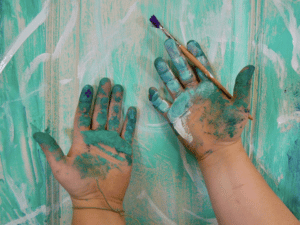Naropa Community Art Studio
Program Information
Menu
Mission Statement: The Socially Engaged Artist and Art Therapist
 One week after 9/11, the Naropa Community Art Studio (NCAS), which is housed in the Transpersonal Contemplative Art–Based Counseling program, was created by Michael A. Franklin, PhD, ATR-BC. The overall goal of this long-term, curriculum-driven project, is to cultivate the socially engaged artist and art therapist. During a unique to Naropa University studio practicum in the first year, students learn how to design, create, and finance a community-based studio.
The guiding vision behind the NCAS project is to provide a space for diverse groups from the local and regional community to gather and create art together. Equal access for our studio members is stressed, particularly people who are marginalized and unlikely to have access to the humanizing practice of engaging in artistic behavior in a communal setting. Respect for cultural, ethnic, gender, and spiritual diversity is a founding principal of the NCAS. Unity in diversity, the birthright to pursue creative expression, and the capacity of visual art to contain and communicate the full range of human experiences comprise the essence of our mission and focus.
In addition to serving the Boulder public, Naropa graduate students will have an opportunity to define, manifest, and engage in a new paradigm for community-based service learning and art therapy education.
One week after 9/11, the Naropa Community Art Studio (NCAS), which is housed in the Transpersonal Contemplative Art–Based Counseling program, was created by Michael A. Franklin, PhD, ATR-BC. The overall goal of this long-term, curriculum-driven project, is to cultivate the socially engaged artist and art therapist. During a unique to Naropa University studio practicum in the first year, students learn how to design, create, and finance a community-based studio.
The guiding vision behind the NCAS project is to provide a space for diverse groups from the local and regional community to gather and create art together. Equal access for our studio members is stressed, particularly people who are marginalized and unlikely to have access to the humanizing practice of engaging in artistic behavior in a communal setting. Respect for cultural, ethnic, gender, and spiritual diversity is a founding principal of the NCAS. Unity in diversity, the birthright to pursue creative expression, and the capacity of visual art to contain and communicate the full range of human experiences comprise the essence of our mission and focus.
In addition to serving the Boulder public, Naropa graduate students will have an opportunity to define, manifest, and engage in a new paradigm for community-based service learning and art therapy education. Founding Vision & Principles
- To create a studio laboratory for researching the role of the socially engaged artist and art therapist working in the 21st century. Of particular interest is the investigation of the rich territory where art is therapeutic without focusing on clinical treatment. As an inclusive project, students are supported to work collaboratively with faculty to research, present, and publish findings.
- To train graduate students in legitimate alternative paradigms for delivering studio-based, art therapy services to communities after graduation.
- To create an accompanying business focused class (CNSA-665) on how to manifest a community art studio. This course addresses business planning, marketing skills, fundraising strategies, and the fundamentals of grant writing.
- To build into the curriculum service as a spiritual practice by blending sitting meditation with a karma-yoga perspective of social engagement, including the value of seva (selfless service). In 2000, Naropa University mostly focused on sitting practice. The NCAS was intended to blend sitting meditation with socially engaged action.
- To provide a pioneering, innovative curricular/contemplative education offering that blends the intersections between graduate training, engaged compassionate action, and a flexible professional identity as an art therapist.
- To make sure that the NCAS was self-sustaining and always free for participants. Additionally, the initial goal was to provide community members access to a thriving art studio on the Naropa University Nalanda campus where visitors would encounter students and university culture. This original intention—following Dr. Wolf Wolfensberger’s research on normalization and social role valorization—strives to make access to the conditions of everyday life available to marginalized people.
Since Our Founding in 2001
- We have hosted more than 700 participant visits per year.
- We have offered approximately 80 sessions per year.
- We have trained approximately 18 mentors per year.
Loading view.
Naropa Community Art Studio (NCAS): Open Studio
Naropa Community Art Studio1630 63rd Street, Suite 2., Boulder, CO, United States
This studio night is for members of the Naropa community to explore their creativity in fellowship with others. We define the Naropa community inclusively; current, prospective, and past students, faculty, staff, partners, […]
Free
Naropa Community Art Studio (NCAS): Open Studio
Naropa Community Art Studio1630 63rd Street, Suite 2., Boulder, CO, United States
This studio night is for members of the Naropa community to explore their creativity in fellowship with others. We define the Naropa community inclusively; current, prospective, and past students, faculty, staff, partners, […]
Free
Naropa Community Art Studio (NCAS): Open Studio
Naropa Community Art Studio1630 63rd Street, Suite 2., Boulder, CO, United States
This studio night is for members of the Naropa community to explore their creativity in fellowship with others. We define the Naropa community inclusively; current, prospective, and past students, faculty, staff, partners, […]
Free

